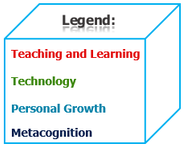ETEC 565A
Learning Technologies: Selection, Design, and Application

"A lesson in development; an extension of metacognition."
In this course we delved into the role of assessment and the conditions required for assessment to support learning (Gibbs & Simpson, 2004). Here, I gained the vernacular to describe the way my learning had shifted when I went from being a below-average student to a very capable one; I had figured out how to cue-seek to discover each instructor’s hidden curriculum.
|
The primary focus of the course was the creation of an introduction and first module of a course in a chosen Learning Management System (I chose Moodle). This, combined with the rigorous reading and discussion schedule, made this the most challenging course of the program for me, but also one of the most valuable! Being near the end of the program for me, many previous concepts, theories, strategies, and technologies were reiterated. My reliance on my own learning and experience from previous courses was instrumental to my success in this course. I had already read a number of the required readings, I was familiar with software such as Moodle, Camtasia, and Video Scribe, and could combine them effectively; and I had a solid understanding of constructivism in an online learning environment. What was incredible, was the sheer amount of time this project took! To develop two high-quality Moodle modules, and introduction and a content module, took probably 60 hours!
|
More on Reiterated Ideas
More on Extending Foundations
More on Technology-Supported Learning Design
|
I would highly recommend this course as one of the later ones in the program.
More on Timelines for Development
An LMS Learning Object
Rather than showcase the entire Moodle project, which can only be shared via a walk-through video, I decided to showcase one learning object from my English Language Arts 30-2 course. While the Moodle modules were the final outcome, I knew that I would lose access to it shortly after the conclusion of the course. As such, I purposefully developed learning objects that I would be able to retain and utilize in my practice, beyond the Moodle shell. What you see below is an interactive image, created with Thinglink, Video Scribe, and Youtube, which allows students to explore the elements of plot. In addition, there is a notes page, which could be used digitally or in hard copy, for students to record their understandings of the definitions and practice applying the concepts to a current novel of study.
|
More on Moodle Teaching/ Development
|
More on Metacognition and Design
|
The fact that I could pull this learning object from the context of the course module as a whole impressed upon me the value of individual learning objects. The shift to e-learning from traditional face-to-face does not need to be incredibly complex, but can occur in smaller steps to begin with; supporting educators where they are at.
More on e-Learning Objects in a Face-to-Face Classroom
Where to Next?
References:
Gibbs, G., & Simpson, C. (2005). Conditions under which assessment supports students’ learning. Learning and Teaching in Higher Education, 1(1), 3-31. Retrieved from http://www.open.ac.uk/fast/pdfs/Gibbs%20and%20Simpson%202004-05.pdf
Therien, J. (2016). Interactive elements of a short story. Learning object. University of British Columbia.
Audio Clip References:
Anderson, T. (2008). “Towards a Theory of Online Learning.” In Anderson, T. & Elloumi, F. Theory and Practice of Online Learning. Athabasca University.
Therien, J. (2015). Keyword post 7: Design. ETEC 510 Unpublished manuscript. University of British Columbia
Veletsianos, G. (2011). Designing Opportunities for Transformation with Emerging Technologies. Educational Technology, 51(2), 41-46.
Gibbs, G., & Simpson, C. (2005). Conditions under which assessment supports students’ learning. Learning and Teaching in Higher Education, 1(1), 3-31. Retrieved from http://www.open.ac.uk/fast/pdfs/Gibbs%20and%20Simpson%202004-05.pdf
Therien, J. (2016). Interactive elements of a short story. Learning object. University of British Columbia.
Audio Clip References:
Anderson, T. (2008). “Towards a Theory of Online Learning.” In Anderson, T. & Elloumi, F. Theory and Practice of Online Learning. Athabasca University.
Therien, J. (2015). Keyword post 7: Design. ETEC 510 Unpublished manuscript. University of British Columbia
Veletsianos, G. (2011). Designing Opportunities for Transformation with Emerging Technologies. Educational Technology, 51(2), 41-46.